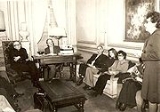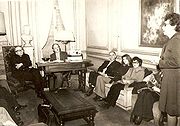
Hugo Gunckel Lüer
Encyclopedia
Hugo Gunckel Lüer was a Chile
an pharmacist
, botanist, and university professor
.
Gunckel is the ICBN author citation
corresponding to Hugo Gunckel.

. His primary and secondary studies were at the Colegio Alemán (founded by Carlos Anwandter
) and in the lyceum of Hombres, enterring the Universidad de Concepción
in 1921, from which he got a degree in pharmacy.
As assistant of botany to the Prof. Alcibíades Santa Cruz, he demonstrated his interest in nature, stimulated by his parents who offered him frequent excursions that allowed him to observe nature, plants, and their development. Later, the study of plants, their properties, and life conditions became a passion.
After graduating he worked as a professional in Talca
, in the pharmacy of Guillermo Kuschel, the distinguished trade union and industrial director, one of the founding partners of the Laboratorio Geka. Later Gunckel returned to Valdivia to serve as the pharmaceutical head of the Railroad Zone IV, work which was later suppressed.
Gunckel moved to Corral, where he started a pharmacy, but the near-virgin landscape that surrounded this port, rich in forests, ferns, and grasses, made him a collector of plant specimens. In 1940 he moved to Temuco
, where he became the director of the Museo Araucano (today the Museo Regional de la Araucanía). In 1943 he was elected the first president of the Temuco Regional Council of the College of Pharmacists of Chile
(Consejo Regional en Temuco del Colegio de Farmacéuticos de Chile), which was led by Victor M. Cereceda. In 1946 he became the president of the School of Forestry Engineers (Escuela de Ingenieros Forestales), the first establishment of the specialty created in Chile. However, he continued studying, and wrote articles for the daily Austral, other newspapers in the region, and scientific journals. He was founding member of the Academia de Ciencias Naturales, which he was president of later for 12 years, and for which he wrote articles they published in their journal over the course of 20 years. With Hans Niemeyer, he edited the "Revista Universitaria-Universidad Católica" or "Anales de la Academia de Ciencias Naturales."
On May 1, 1950 he moved to Santiago to fill the botany chair in the Facultad de Farmacia, which was directed by the professor Juan Ibáñez, who performed duties for UNESCO
and thus was frequently travelling. His mission was the formation of the herbarium of the School of Chemistry and Pharmacy. At the same time, Gunckel taught classes at the Instituto Pedagógico de la Universidad de Chile, today the Universidad Metropolitana de Ciencias de la Educación, where he continued to serve until he retired in 1968. This body's journal Academia published some of his works related to botany and history (Gunckel 1982). He became an honorary member of the Sociedad Chilena de Historia y Geografía and a member of the Academia Chilena de la Lengua
.
Hugo Gunckel was also the founder and subdirector of the Third Company of Firefighters of Corral and served as mayor of the community.
He died in Santiago de Chile at the age of 96.
Articles
Chile
Chile ,officially the Republic of Chile , is a country in South America occupying a long, narrow coastal strip between the Andes mountains to the east and the Pacific Ocean to the west. It borders Peru to the north, Bolivia to the northeast, Argentina to the east, and the Drake Passage in the far...
an pharmacist
Pharmacist
Pharmacists are allied health professionals who practice in pharmacy, the field of health sciences focusing on safe and effective medication use...
, botanist, and university professor
Professor
A professor is a scholarly teacher; the precise meaning of the term varies by country. Literally, professor derives from Latin as a "person who professes" being usually an expert in arts or sciences; a teacher of high rank...
.
Gunckel is the ICBN author citation
Author citation (botany)
In botanical nomenclature, author citation refers to citing the person who validly published a botanical name, i.e. who first published the name while fulfilling the formal requirements as specified by the International Code of Botanical Nomenclature...
corresponding to Hugo Gunckel.

Life
Gunckel was born in ValdiviaValdivia, Chile
Valdivia is a city and commune in southern Chile administered by the Municipality of Valdivia. The city is named after its founder Pedro de Valdivia and is located at the confluence of the Calle-Calle, Valdivia and Cau-Cau Rivers, approximately east of the coastal towns of Corral and Niebla...
. His primary and secondary studies were at the Colegio Alemán (founded by Carlos Anwandter
Carlos Anwandter
Carlos Anwandter was a German political exile that emigrated to Valdivia, Chile in 1850 after participating in the Revolutions of 1848...
) and in the lyceum of Hombres, enterring the Universidad de Concepción
Universidad de Concepción
The University of Concepción , also known for its acronym UdeC, is one of the most prestigious universities in Chile. It is the third oldest university in the country, and it is part of the Council of Rectors. It was the first University founded in the South of Chile, and the first to become a...
in 1921, from which he got a degree in pharmacy.
As assistant of botany to the Prof. Alcibíades Santa Cruz, he demonstrated his interest in nature, stimulated by his parents who offered him frequent excursions that allowed him to observe nature, plants, and their development. Later, the study of plants, their properties, and life conditions became a passion.
After graduating he worked as a professional in Talca
Talca
Talca is a city and commune in Chile located about south of Santiago, and is the capital of both Talca Province and Maule Region . As of the 2002 census, the city had a population of 193,755....
, in the pharmacy of Guillermo Kuschel, the distinguished trade union and industrial director, one of the founding partners of the Laboratorio Geka. Later Gunckel returned to Valdivia to serve as the pharmaceutical head of the Railroad Zone IV, work which was later suppressed.
Gunckel moved to Corral, where he started a pharmacy, but the near-virgin landscape that surrounded this port, rich in forests, ferns, and grasses, made him a collector of plant specimens. In 1940 he moved to Temuco
Temuco
Temuco is a city and commune, capital of the Cautín Province and of the Araucanía Region in southern Chile. The name comes from the Mapudungun language, meaning "temu water"; "temu" is a tree used by Mapuches for medicinal purposes. The city is located 670 km south of Santiago...
, where he became the director of the Museo Araucano (today the Museo Regional de la Araucanía). In 1943 he was elected the first president of the Temuco Regional Council of the College of Pharmacists of Chile
Council of the College of Pharmacists of Chile
Council of the College of Pharmacists of Chile The Colegio Químico-Farmacéutico A. G., abbreviated as Colegio Químico Farmacéutico, is the Chilean association of individuals, a national pharmacy association that represents pharmacists, and chemical pharmacists. It was founded in 1942 by law number...
(Consejo Regional en Temuco del Colegio de Farmacéuticos de Chile), which was led by Victor M. Cereceda. In 1946 he became the president of the School of Forestry Engineers (Escuela de Ingenieros Forestales), the first establishment of the specialty created in Chile. However, he continued studying, and wrote articles for the daily Austral, other newspapers in the region, and scientific journals. He was founding member of the Academia de Ciencias Naturales, which he was president of later for 12 years, and for which he wrote articles they published in their journal over the course of 20 years. With Hans Niemeyer, he edited the "Revista Universitaria-Universidad Católica" or "Anales de la Academia de Ciencias Naturales."
On May 1, 1950 he moved to Santiago to fill the botany chair in the Facultad de Farmacia, which was directed by the professor Juan Ibáñez, who performed duties for UNESCO
UNESCO
The United Nations Educational, Scientific and Cultural Organization is a specialized agency of the United Nations...
and thus was frequently travelling. His mission was the formation of the herbarium of the School of Chemistry and Pharmacy. At the same time, Gunckel taught classes at the Instituto Pedagógico de la Universidad de Chile, today the Universidad Metropolitana de Ciencias de la Educación, where he continued to serve until he retired in 1968. This body's journal Academia published some of his works related to botany and history (Gunckel 1982). He became an honorary member of the Sociedad Chilena de Historia y Geografía and a member of the Academia Chilena de la Lengua
Academia Chilena de la Lengua
The Academia Chilena de la Lengua is an association of academics and experts on the use of the Spanish language in Chile. It is a member of the Asociación de Academias de la Lengua Española....
.
Hugo Gunckel was also the founder and subdirector of the Third Company of Firefighters of Corral and served as mayor of the community.
He died in Santiago de Chile at the age of 96.
Works
Books- Helechos de Chile Monografías Anexos de los Anales de la Universidad de Chile, 245 pp.
- Bibliografía Moliniana Fondo Andrés Bello, 166 pp.
Articles
- (1948) "La floración de la quila y el coligüe en la Araucanía." Ciencia e Investigación 4: 91-95.
- (1953) "Plantas chilenas estudiadas por Linneo." Revista Universitaria (Chile) 38: 67-76
- (1959) "Nombres indígenas relacionados con la flora chilena." Facultad de Química y Farmacia, Universidad de Chile, Santiago de Chile,
- (1967) "Fitonimia atacameña, especialmente cunza." Anales de la Academia Chilena de Ciencias Naturales 52: 1 – 81
- (1972) "Plantas chilenas descritas como nuevos por Juan Ignacio Molina y sus concordancias con la nomenclatura botánica actual." Noticiario Mensual del Museo Nacional de Historia Natural, Año 17 (N° 197):3-11.
- (1979) "Vocablos populares técnicos relacionados con la industria del alerce" Noticiario Mensual del Museo Nacional de Historia Natural 274-275
- (1980) "Plantas magicas mapuche." Terra Ameriga 41:73-75.
- (with C. Munizaga, 1958) "Notas etnobotánicas del pueblo atacameño de Socaire, o etnobotánica de Socaire." Publicaciones del Centro de Estudios Antropológicos 5: 9-40.
- (1982). Significado de nombres genéricos de algunas plantas de la flora chilena. Academia N° 4. Academia Superior de Ciencias Pedagógicas. 157-180 Chloris chilensis vol. 9., Nº2)
External links
- Sandoval, C. (2002). Desarrollo de los estudios de Farmacia en Concepción. Anal. Real Acad. Nac. Farm 111-156

